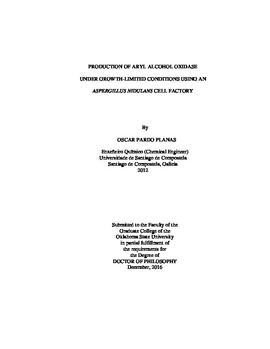| dc.contributor.advisor | Wilkins, Mark Robert | |
| dc.contributor.author | Pardo Planas, Oscar | |
| dc.date.accessioned | 2018-06-25T13:38:27Z | |
| dc.date.available | 2018-06-25T13:38:27Z | |
| dc.date.issued | 2016-12 | |
| dc.identifier.uri | https://hdl.handle.net/11244/300258 | |
| dc.description.abstract | Trickle bed reactors (TBRs) have potential to be used for enzyme production due to reduced energy demands and easier product recovery compared to traditional submerged fermentations. The ligninolytic consortium is a group of enzymes found in microorganisms capable of degrading lignin. The identification and production of these enzymes could enable new pretreatment processes that compete with the harsh and costly chemical and/or physical methods for lignin removal from biomass in biorefineries. In the present study one of the enzymes from the ligninolytic consortium, an aryl alcohol oxidase, was produced using an Aspergillus nidulans cell factory. The strain was constructed using DNA mediated transformation and it contained a pyridoxine auxotrophic marker to regulate growth. Growth limitation can prevent clogging issues in the TBR system associated with excessive growth. The most important challenge observed during growth limitation conditions was the production of melanin, which was more prominent when the cell factory was cultured in the TBR than in shaken flasks, probably due to higher oxygen availability in the TBR. Different approaches were evaluated to reduce or suppress melanization of the A. nidulans cultures. Reducing copper concentrations and including pigmentation inhibitors in the media, such as tropolone or ascorbic acid, reduced melanin formation and enhanced aryl alcohol oxidase activity in submerged cultures. When continuous aryl alcohol oxidase production was established in the TBR, the use of media with no copper and 5 g/L ascorbic acid paired with 110 mL/min air flow rate reduced melanization and increased enzyme activities as opposed to other conditions. Aryl alcohol oxidase productivities were increased 20 to 140% when melanization was prevented, reaching a maximum of 2.4 U/mL*h. Three different random packing materials were evaluated as inert support in the TBR, two made of HDPE plastic and one of stainless steel. Additionally, three dilution rates (0.034, 0.038, 0.048 h-1) were used. All packing materials were suitable for A. nidulans culture in a TBR and no significant differences were observed among them. Increasing the dilution rate favored melanin and acid formation, lowering enzyme production. | |
| dc.format | application/pdf | |
| dc.language | en_US | |
| dc.rights | Copyright is held by the author who has granted the Oklahoma State University Library the non-exclusive right to share this material in its institutional repository. Contact Digital Library Services at lib-dls@okstate.edu or 405-744-9161 for the permission policy on the use, reproduction or distribution of this material. | |
| dc.title | Production of aryl alcohol oxidase under growth-limited conditions using an Aspergillus nidulans cell factory | |
| dc.contributor.committeeMember | Bellmer, Danielle D. | |
| dc.contributor.committeeMember | Atiyeh, Hasan K. | |
| dc.contributor.committeeMember | Prade, Rolf A. | |
| dc.contributor.committeeMember | Aichele, Clint P. | |
| osu.filename | PardoPlanas_okstate_0664D_14936.pdf | |
| osu.accesstype | Open Access | |
| dc.type.genre | Dissertation | |
| dc.type.material | Text | |
| thesis.degree.discipline | Biosystems Engineering | |
| thesis.degree.grantor | Oklahoma State University | |
